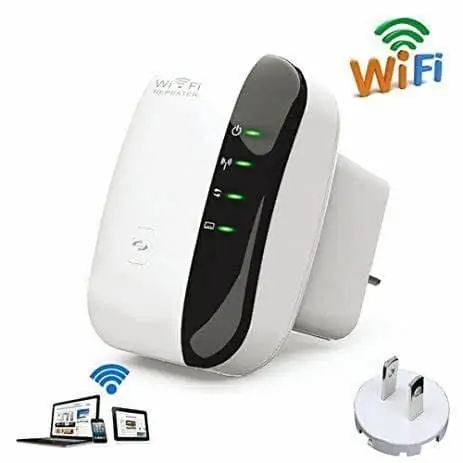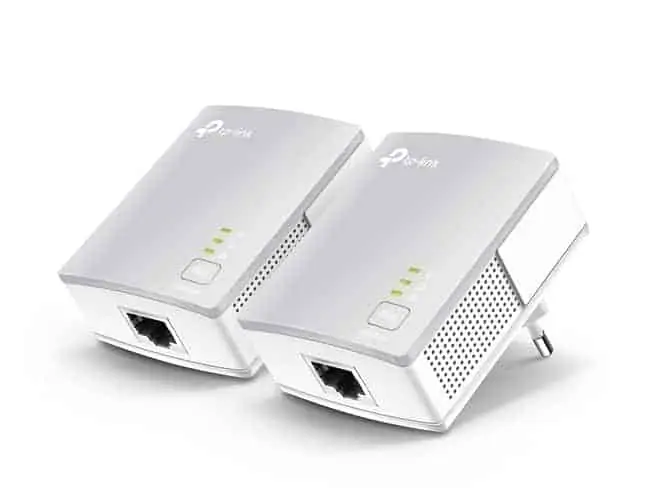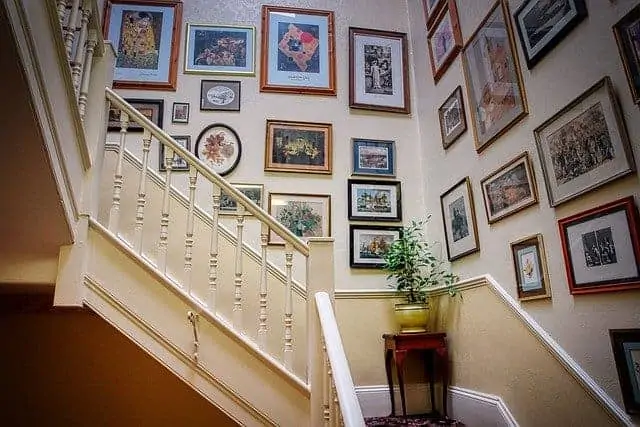Some links in this article are affiliate links and I may receive a small commission from purchases made off them at no extra cost to the reader.
No one likes to have a weak Wi-Fi signal, but even with modern routers it still happens and is more likely the further away you are from your router. The more obstacles (walls, doors, floors, people, furniture) a Wi-Fi signal has to travel through before it reaches a device from the router, the more likely the signal is to be disrupted and weakened and the more likely you are to experience lag in gaming or buffering in videos.
This problem obviously gets more common if you are trying to use the internet upstairs and your router is downstairs. The signal is more likely to drop out and cause lag, buffering or slow loading pages for people on the first floor or above in the home.
There are some quick steps we can take to try and fix this, which we’ll cover immediately below, but what if these don’t work and we still have a weak Wi-Fi signal upstairs?
Thankfully, there are are variety of home networking solutions which can help to solve this problem, ranging from basic single plug extender models, to powerline adapters, to full on mesh systems, to boost wireless and wired connectivity in the home. We’ll cover all of these options, listing the pro’s and cons of each for different situations.
One way or another, there usually is a way to fix weak Wi-Fi signals upstairs and get a better connection even at distance from the router on the first or second floors of a property. Let’s go through some quick solutions and then some more in depth options you have to solve this problem.
Quick Fire Tips For Fixing Weak Wi-Fi Upstairs
Here are some very quick steps you can try and take to fix a weak Wi-Fi signal upstairs.
- Reset your router and devices.
- Try to move your router and devices closer together, if possible.
- If there are any obvious and clear obstructions between your router and device that can be moved, then move them. (eg. movable furniture, stands, racks, household or DIY “stuff” lying around etc.)
- Try and get on a wired connection by running a long ethernet cable through the house if you can do this or want to.
- Check if you can at least get a proper connection plugged into your router. If not, the router itself may be broken, and you’ll need to contact your ISP for repair or replacement.
- If you have had your current router a long time, also contact your ISP and see if there is a more up to date router they can send you with better performance.
- Signals may be weaker in general at busy peak times when lots of people are using the internet at the same time. Try again at quieter times or try plugging into your router instead,
These are pretty obvious solutions but are worth trying as a short term fix, whilst working on a more permanent solution. If your problem with weak Wi-Fi upstairs is a one-off or rare event, then doing one of these things may fix it, but if it’s more common or permanent, that’s when you’ll likely have to invest in some kind of home networking solution to get a better all round signal.
But this can all be very confusing, between Wi-Fi boosters, extenders, powerlines and mesh systems, which one is best in which circumstances, and how much does these things cost?
This is what we’ll cover in the rest of this post, going through all the different home networking solutions you can try to fix the problem of weak Wi-Fi upstairs, detailing the relative costs of each solutions, and when each might be better for you.
Basic Solution – Wi-Fi Range Extenders (Boosters)
If you’ve got a problem with weak Wi-Fi in the home, then the most basic home networking product you can try to solve this is a simple range extender, sometimes also known as a signal boosters or Wi-Fi boosters.
These are simple single plug adapters that you plug into the wall, and they “capture” and amplify the existing signal from the router, hopefully spreading it more reliably to more remote parts of the house, including upstairs.
And that’s really it for range extenders. They are a more basic product that aim to boost the Wi-Fi signal further. Loads of different models are available.
See the video below for an excellent 2 minute demonstration of how Wi-Fi range extender models work. They work best when installed in direct line of sight of the router.
Here are the situations when a Wi-Fi Range Extender Model might be a good option:
- For getting a better signal upstairs for lower bandwidth activities like basic browsing, emails, casual slow paced online games, perhaps light streaming.
- If you need to extend the signal just to one specific room or corner of the house, or to a specific device (eg. home office in the room next to the router).
- If you live in a open plan apartment.
- They work best over short to medium distances, and in open plan spaces. They may or may not work well in more traditional home layouts.
- Performance of range extenders can be hit and miss, since you are still on Wi-Fi, even if it’s boosted. Some people get great results using extenders; others less so.
- You don’t have a massive budget. Range extenders can be bought for very cheap prices.
Here’s a popular Range Extenders model (click paid/affiliate links below to view products on Amazon):
Netgear Wi-Fi Range Extender EX3700 – Cheaper lower end extender model, but still has decent average review scores from plenty of ratings. Easy setup, small discrete white plug design, and generally reported to have decent range. Also has an ethernet port to connect up a wired device if needed.

Range Extenders are the simplest of the home networking solutions for weak Wi-Fi
More Advanced Solution – Powerline Adapters
If you are wanting a more advanced solution, then a powerline adapter is one step up from a range extender or Wi-Fi Booster.
Powerline adapters consist of two adapter plugs instead of one, and are good for bypassing Wi-Fi altogether and creating a wired connection upstairs instead. You plug one adapter in and connect it to your router, you plug the other adapter in and connect it to your device.
The two plugs then communicate through the electrical wiring of the house to deliver a wired internet connection to your device, effectively turning your wall socket into an internet connection.
They are a clever and under-utilized home networking solution that can very effectively deliver a strong internet connection upstairs, or to any other part of the house further away from the router, where the Wi-Fi signal may be weak and inconsistent.

You can find links to the TP Link Nano Powerline adapter, plus more advanced models, on our Powerline Adapters page.
The fact that powerline adapters deliver a wired connection can give them some clear advantages over Wi-Fi Range Extenders in some cases.
Here is when a powerline adapter may be a good option for you:
- You are doing some more heavy duty things like HD streaming, and need the best possible connection to deliver the most bandwidth possible.
- Netflix streamers, YouTube streamers etc. Anything where you would rather have a wired connection if possible but are too far away from the router to run a cable directly.
- You are playing games online upstairs in a more serious manner, where you need low ping and a stable connection. A wired connection is better than Wi-Fi for this.
- You are a long way from the router upstairs, and are not sure a simple Range Extenders is going to extend the signal far enough (their performance does vary)
- The electrical wiring in your house is in good condition to allow the adapters to communicate, and is wired normally, running off just one meter or feed.
- If you also want to connect wireless portable devices, like tablets, iPhones etc, then more advanced wireless powerline adapter models are available, which deliver a cloned Wi-Fi access point as well as ethernet connections.
- In rare cases, powerline adapters may not work very well, if the house wiring is in poor condition, or the circuitry is unusual. See our article for more on these rare cases.
When they work well, powerline adapters can deliver most of the bandwidth you’d get plugged directly into the router, and virtually identical latency or ping. They can also deliver a more reliable connection than Wi-Fi, and in this sense can be good for solving the problem of weak Wi-Fi upstairs.
Top Range Solution – Wi-Fi Mesh Systems
If you don’t like the sound of either range extenders or powerline adapters, and want a more comprehensive wireless only networking solution that will deliver a stronger signal upstairs, and all through the house in general, than a Wi-Fi Mesh System may be something else to consider.
These can be seen as more advanced (and more expensive) versions of the simpler range extender models.
Mesh systems consist of a kit of 2 or 3 pods or “nodes” that you place in certain parts of the house, to boost and amplify the wireless signal
In this sense, they work in a similar way to extenders, but by using more advanced and reliable technology. They are much more expensive as a result.
You connect one node to your existing router, and this becomes your new “main” router. You then place the other one or two pods around the home so they can capture and boost wireless coverage more reliably upstairs and to all parts of the home.
See the video for a demonstration of how mesh systems work.
You can view the popular Netgear Orbi Mesh router (paid link), plus more models, on Amazon.
Here are some cases when Wi-Fi Mesh Systems may be a good option, despite the greater cost:
- You live in a large two storey or three storey home, with some people a long way from the router, and really want to guarantee better wireless coverage to all parts of the house upstairs.
- You have multiple users in different parts of the home (upstairs and elsewhere), not just in one room, who all need a more reliable connection for streaming etc.
- You don’t want to use wired connections at all, and want to stay on wireless only for convenience.
- Your connectivity problems are with portable devices that can only use Wi-Fi anyway and range extenders aren’t a good option.
- Budget is less of an issue and you are willing to spend a bit more money to solve the problem.
Wi-Fi Mesh Systems are a much more sophisticated solution, and have become quite reliable as the manufacturers have perfected the technology since they began to be widely sold several years ago. They’ll set you back more, but can really help in larger homes when you need a good signal over a larger area.
Summary
Let’s just quickly go over your options again in terms of products for getting a better Wi-Fi signal upstairs:
- Simple Solution – Range Extenders – Single plug boosters, good for shorter distances, lighter internet use. Cheaper option. See our extenders page for some models.
- More Advanced Solution – Powerline Adapters – Good for delivering wired connections for gaming and streaming. Wireless models also available for more all round solution.
- Top Range Solution – Mesh Systems – More advanced, expensive kits. Deliver better wireless signals over a larger area. Good for large homes.
